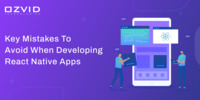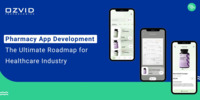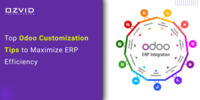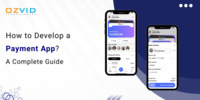- Aug 13, 2025
Share this post on:
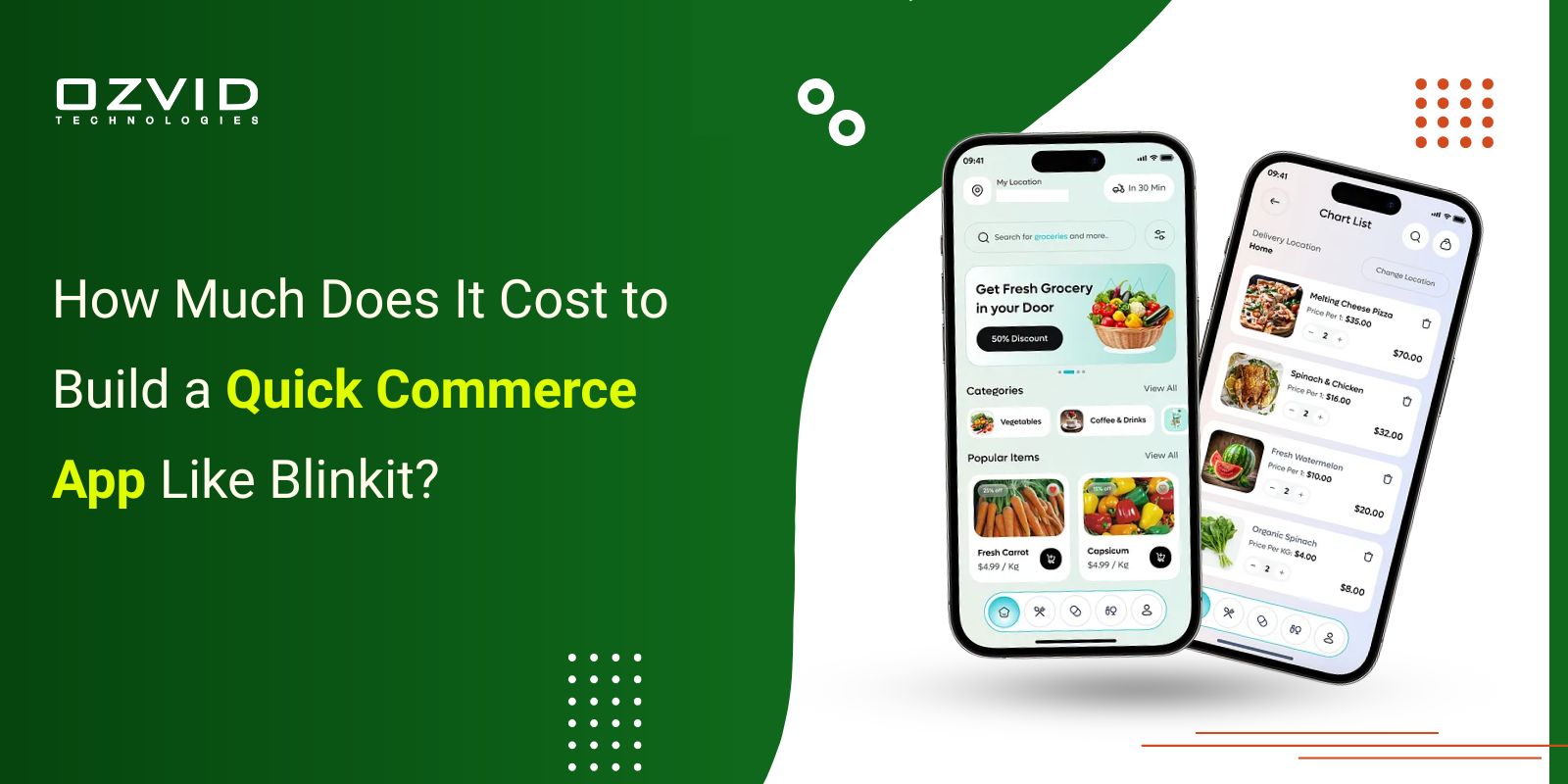
Did you know the Quick Commerce market is on a rapid growth track, with revenue forecasted to touch around USD 5.38 billion in 2025 and expected to surge to nearly USD 11.08 billion by 2030 at a CAGR of 15.54%? The way people shop for daily essentials has changed dramatically over the last few years. With rising urbanization, busy lifestyles, and the need for convenience, Quick Commerce Apps have revolutionized the way consumers buy groceries and household items. From placing an order to receiving it at your doorstep in just 10–20 minutes, platforms like Blinkit have set new benchmarks in the instant grocery delivery app market.
For businesses, investing in grocery shopping app development is no longer an option, it is a necessity. Whether you’re a retail chain, an entrepreneur, or an e-commerce brand, entering the quick commerce segment can give you a competitive advantage in the growing digital marketplace. As a leading Quick Commerce App development company, OZVID Technologies has helped several clients turn their innovative grocery delivery ideas into profitable businesses.
In this blog, we will cover everything you need to know about building a Quick Commerce App like Blinkit, including its features, business model, cost, challenges, future trends, and how OZVID Technologies can help you bring your vision to life.
Key Takeaways
- Quick Commerce Apps like Blinkit are transforming the grocery industry by offering ultra-fast delivery within minutes.
- Building a grocery delivery app requires careful planning, the right features, and a strong operational strategy.
- The ecommerce app development cost for a Blinkit-style platform depends on features, tech stack, and complexity.
- Partnering with an experienced Quick Commerce App development company ensures scalability, performance, and user satisfaction.
What is a Quick Commerce App?
A Quick Commerce App (Q-commerce app) is a next-generation retail solution designed to deliver products within minutes of ordering. Unlike traditional e-commerce, which may take hours or even days for delivery, quick commerce focuses on speed, convenience, and limited but essential product categories such as groceries, snacks, beverages, and personal care items.
Popular examples include Blinkit, Zepto, Swiggy Instamart, and Dunzo, all of which offer rapid delivery through strategically located micro-warehouses or dark stores. These apps combine efficient logistics, real-time inventory tracking, and intuitive UI/UX design to provide an exceptional shopping experience.
If you are looking to build the best grocery delivery app, understanding the quick commerce model is the first step toward success.
How Does the Quick Commerce Business Model Work?
The Quick Commerce business model is designed to fulfill the growing consumer demand for speed, convenience, and reliability in online shopping. Unlike traditional e-commerce, where delivery windows range from several hours to a few days, Quick Commerce Apps focus on delivering products, especially daily essentials, within minutes. The model operates on an agile framework that combines technology, logistics, and strategic inventory placement to achieve lightning-fast order fulfillment.
Let’s break down the key components that make this business model work so efficiently:
1. Focused Product Range
Instead of offering thousands of product categories like large e-commerce marketplaces, Quick Commerce Apps prioritize a carefully curated inventory of high-demand items such as:
- Fresh groceries and vegetables
- Dairy and bakery products
- Snacks and beverages
- Personal care and hygiene items
- Household essentials
This limited selection ensures faster order processing, minimal picking errors, and higher inventory turnover rates.
2. Dark Stores and Micro-Warehouses
The backbone of the quick commerce model is its network of dark stores or micro-warehouses. These are strategically located storage hubs situated close to high-demand urban areas. Unlike large traditional warehouses, they are compact, stocked with fast-selling items, and designed for rapid order processing. Their proximity to customers allows delivery partners to pick up orders quickly, enabling the promise of ultra-fast delivery within a few minutes.
3. Real-Time Inventory Updates
A successful Quick Commerce App relies heavily on accurate, real-time inventory tracking. The app shows only the products available at the nearest micro-warehouse, preventing issues like stockouts or last-minute cancellations. This level of transparency not only improves the customer experience but also helps businesses manage their stock efficiently, optimize order fulfillment, and avoid wastage, which is crucial for maintaining profitability in such a fast-paced model.
4. Efficient Delivery Network
Speed is the selling point of quick commerce, and achieving it requires an agile and efficient delivery fleet. Delivery agents are strategically stationed in high-demand zones, ready to collect and drop off orders at a moment’s notice. With GPS navigation, route optimization, and real-time tracking integrated into the app, the process becomes seamless, ensuring that customers receive their groceries and essentials exactly when promised, often within 10–20 minutes.
5. Revenue Model
Quick commerce platforms like Blinkit adopt multiple revenue streams to remain profitable. These include delivery charges for small orders, commissions from partner vendors, subscription plans for free deliveries, promotional fees from brands for priority listing, and even in-app advertising. This diversified model ensures consistent revenue while allowing the platform to keep operational costs in check, thus sustaining the promise of rapid delivery without compromising service quality.
Features of a Quick Commerce App
A Quick Commerce App is not just another grocery delivery app, it is a high-performance digital platform designed to meet the modern consumer’s demand for speed, convenience, and reliability. To compete with industry leaders like Blinkit, your app must go beyond basic e-commerce functionality and deliver a seamless, fast, and engaging experience to customers, delivery partners, and administrators alike.
At OZVID Technologies, we follow a feature-first approach in grocery shopping app development to ensure that your instant grocery delivery app has the capabilities to scale, retain customers, and operate efficiently.
Here’s a comprehensive breakdown of the core features every successful Quick Commerce App should have:
1. User Panel Features – For Your Customers
This is the heart of your best grocery delivery app, where user experience directly determines your retention rates and brand loyalty.
Quick & Easy Onboarding
Sign-up through social media, Google, Apple ID, or phone number with OTP verification. The process should be simple enough to get users shopping in seconds.
Personalized Home Screen
Show products based on the user’s past purchases, location, and preferences using AI-powered recommendations.
Advanced Search and Smart Filters
Allow customers to find their products instantly with category filters, price sorting, and voice search integration for a faster checkout process.
Real-Time Inventory Display
Avoid disappointment by showing only products available in the user’s nearest fulfillment center or dark store.
Multiple Payment Methods
Integrate UPI, credit/debit cards, digital wallets, and cash-on-delivery to ensure flexibility.
Live Order Tracking
Customers should see their order’s status in real-time—when it’s packed, picked, and on the way.
Reorder in One Click
A shortcut for frequently bought items, making grocery shopping app delivery even faster.
Push Notifications
Instant updates about order status, discounts, and special offers to keep customers engaged.
2. Delivery Partner Features – For Your Riders
A fast delivery system is the backbone of any instant grocery delivery app. Without empowering your delivery agents, the promise of “10-minute delivery” becomes impossible.
Optimized Delivery Requests
Delivery partners get automated task assignments based on location and delivery time targets.
In-App Navigation & GPS Tracking
Integrated maps help riders find the fastest route to the delivery address.
Order & Status Management
Drivers can update their status (order picked, on the way, delivered) in real-time.
Earnings Dashboard
Transparent earnings history for daily and weekly payouts builds trust with delivery partners.
3. Admin Panel Features – For Your Business Control
The admin dashboard is the command center for managing the online grocery app. It should provide full visibility and control over orders, products, and user behavior.
Product & Inventory Management
Add, edit, or remove products while tracking stock levels across different fulfillment centers.
Order Management
View and manage all incoming orders, assign them to delivery agents, and resolve issues quickly.
User & Delivery Partner Management
Keep track of customer accounts, delivery agents, and vendor relationships in one place.
Analytics & Reporting
Get detailed reports on sales, delivery times, peak order hours, and customer preferences.
Promotions & Loyalty Programs
Manage offers, discount codes, and reward systems to boost repeat purchases.
Complaint Resolution System
Track and resolve customer complaints for better service ratings.
4. Advanced Features to Stand Out from Competitors
To compete with brands like Blinkit, adding advanced functionalities to your groceries app can significantly improve customer loyalty and operational efficiency.
AI-Powered Product Recommendations – Suggest products based on purchase history.
Dynamic Pricing – Adjust prices based on demand, time of day, or inventory availability.
Subscription Plans – Offer unlimited free deliveries for a monthly or yearly fee.
Dark Store Management – Enable admins to monitor and optimize multiple micro-warehouses.
In-App Chat Support – Real-time assistance for customers facing issues.
Multi-Language Support – Cater to diverse demographics in different cities.
How to Build a Quick Commerce App
Building a Quick Commerce App like Blinkit is not just about coding an app, it is about creating a complete ecosystem that connects customers, delivery partners, and inventory in real-time while ensuring speed, efficiency, and scalability. At OZVID Technologies, we follow a structured and strategic approach to ensure your grocery delivery app stands out in the competitive market.
Below is a step-by-step breakdown of the process:
1. Conduct In-Depth Market Research
Before you write a single line of code, it’s crucial to understand your target audience, competitors, and market dynamics.
- Identify Demand: Research the shopping habits of your target city or region. What are customers buying most frequently?
- Competitor Analysis: Study platforms like Blinkit, Zepto, and Swiggy Instamart to understand their strengths and weaknesses.
- Market Gaps: Find areas where existing players fall short—this could be product variety, delivery speed, or user experience.
This stage ensures that your grocery shopping app development plan is backed by solid data.
2. Define Your Business Model
The quick commerce ecosystem supports multiple business models, and choosing the right one will shape your development approach.
- Inventory-Led Model: You stock goods in your own micro-warehouses (used by Blinkit).
- Marketplace Model: Partner with local grocery stores and list their inventory on your online grocery app.
- Hybrid Model: A mix of both for flexibility and wider reach.
Your business model will also determine the operational costs and ecommerce app development cost.
3. Finalize the Feature List
The features you include will directly impact user satisfaction and your app’s success.
- Must-Have User Features: Easy onboarding, advanced search filters, product recommendations, real-time inventory updates, multiple payment methods, live order tracking, push notifications.
- Delivery Partner Features: Order acceptance, GPS navigation, route optimization, earnings tracker, delivery status updates.
- Admin Features: Inventory management, store management, order tracking dashboard, analytics, promotional controls.
Our role as a Quick Commerce App development company is to ensure these features are implemented without compromising performance.
4. Choose the Right Technology Stack
A Quick Commerce App needs to handle thousands of transactions per minute without lag. The right tech stack ensures stability, scalability, and security.
- Front-End: React Native or Flutter for cross-platform mobile apps.
- Back-End: Node.js, Python (Django/Flask), or Java Spring Boot.
- Database: MongoDB, PostgreSQL, or MySQL.
- Real-Time Updates: Socket.io or Firebase.
- Payment Gateways: Razorpay, Stripe, PayPal, Paytm.
- Cloud Hosting: AWS, Google Cloud, or Azure for scalable performance.
Choosing high-performance frameworks can slightly increase your ecommerce app development cost but ensures long-term reliability.
5. Create a User-Centric UI/UX Design
Your instant grocery delivery app should be visually appealing, intuitive, and quick to navigate.
- Minimal Clicks: Ensure users can place an order in under 3 taps.
- Category Clarity: Organize groceries into well-defined sections.
- Seamless Checkout: Reduce cart abandonment by simplifying the payment flow.
- Mobile-First Design: Optimize for both Android and iOS devices.
6. Develop the Application
The actual development process typically follows Agile methodology for flexibility and speed.
- Frontend Development: Focus on responsive layouts, smooth animations, and user interactions.
- Backend Development: Build APIs for real-time product updates, user authentication, and order management.
- Integration: Implement payment gateways, push notification systems, and analytics tools.
- Testing at Each Sprint: Continuous testing avoids large-scale issues later.
7. Test for Quality and Performance
Quality assurance is essential to avoid poor user experiences and negative reviews.
- Functional Testing: Ensure every feature works as intended.
- Load Testing: Verify the app can handle high traffic during peak hours.
- Security Testing: Protect user data with encryption and secure APIs.
- Beta Testing: Release the app to a small group of users for real-world feedback.
8. Launch Your App
Once your groceries app passes all tests, it’s time for deployment.
- App Store Optimization (ASO): Optimize app titles, descriptions, and keywords for better discoverability.
- Marketing Campaigns: Use social media ads, influencer collaborations, and referral programs to attract users quickly.
- Promotional Offers: Launch discounts or free deliveries to encourage initial orders.
9. Monitor and Optimize
The launch is just the beginning. Continuous improvement keeps your grocery shopping app delivery competitive.
- User Feedback Analysis: Make updates based on user suggestions.
- Feature Enhancements: Introduce AI-driven recommendations, loyalty points, or voice ordering.
- Performance Tracking: Monitor analytics to identify growth opportunities.
How Much Does Quick Commerce App Development Cost?
One of the most common questions entrepreneurs and businesses have before stepping into the quick commerce industry is: How much will it cost to develop a quick commerce app like Blinkit?
The answer depends on multiple factors because Quick Commerce App development cost is not a fixed number—it varies based on the scope, complexity, and goals of your project. Developing a high-performance instant grocery delivery app involves more than just building a basic application, it requires integrating advanced features, ensuring seamless operations, and creating a user experience that meets modern customer expectations for speed and convenience.
Key Factors Influencing Development Cost
Feature Set and Complexity
The more sophisticated features you integrate, such as real-time order tracking, AI-driven product recommendations, multi-payment gateway support, and advanced inventory management, the higher the development cost. For instance, a simple online grocery app with basic ordering and delivery features will cost significantly less than a fully customized grocery shopping app delivery platform equipped with automation, predictive analytics, and loyalty programs.
Platform Choice (Android, iOS, or Both)
If your target audience uses both Android and iOS devices, you may opt for cross-platform development. While this can reduce time-to-market, it still affects the budget. Native development for each platform typically costs more but can deliver better performance.
UI/UX Design Quality
In quick commerce, the user experience is crucial. A clean, intuitive interface ensures customers can browse products, place orders, and make payments in seconds. High-quality, custom UI/UX design contributes to both better engagement and higher development costs.
Tech Stack and Integrations
Choosing the right technology stack (frameworks, databases, APIs) and integrating third-party services like payment gateways, SMS notifications, push alerts, and mapping tools will also impact the budget.
Development Team’s Expertise and Location
The cost of hiring a Quick Commerce App development company varies by region. Developers in countries like the USA, UK, or Australia tend to have higher hourly rates than those in India. However, partnering with an experienced team ensures you get high-quality results without unnecessary delays.
Maintenance and Post-Launch Support
The cost doesn’t stop once your grocery delivery app goes live. Continuous updates, bug fixes, security patches, and feature enhancements are necessary to keep the app competitive.
Estimated Cost Range
While every project is unique, here’s a general estimate:
Basic Quick Commerce App (essential features, single platform): $25,000 – $35,000
Mid-Level App (cross-platform, advanced features, better UI/UX): $40,000 – $55,000
Advanced App (AI features, scalability, real-time analytics, premium integrations): $60,000 – $70,000+
Development Phase | Description | Estimated Cost Range (USD) | Estimated Timeline |
|---|---|---|---|
Market Research & Planning | Competitor analysis, requirement gathering, feature listing, and business model planning. | $2,000 – $4,000 | 1–2 weeks |
UI/UX Design | Wireframes, user flow creation, and custom interface design for mobile platforms. | $3,000 – $6,000 | 2–3 weeks |
Backend Development | Server-side programming, database setup, API creation, and admin panel development. | $6,000 – $12,000 | 4–6 weeks |
Frontend Development (Mobile App) | Building the app interface for Android, iOS, or both (native or cross-platform). | $8,000 – $18,000 | 5–8 weeks |
Feature Integrations | Adding payment gateways, push notifications, GPS tracking, chat support, etc. | $4,000 – $8,000 | 2–4 weeks |
Testing & Quality Assurance | Functional, performance, usability, and security testing to ensure a bug-free experience. | $2,000 – $5,000 | 2–3 weeks |
Deployment | Launching the app on Google Play Store and Apple App Store with store optimization. | $1,000 – $2,000 | 1 week |
Post-Launch Support & Maintenance | Updates, bug fixes, security patches, and feature upgrades after launch. | $500 – $1,500 per month | Ongoing |
Remember, the ecommerce app development cost also depends on your marketing and operational setup after launch. Your total investment should include app development, infrastructure (servers, cloud hosting), and initial promotional campaigns to acquire customers.
If you work with a skilled Quick Commerce App development company like OZVID Technologies, you get the benefit of efficient development processes, scalable architecture, and cost-effective solutions without compromising quality.
Future Trends in Quick Commerce Apps
The quick commerce industry is still in its growth phase, and its future is expected to be shaped by evolving consumer expectations, technological advancements, and innovative business models. As competition increases, staying ahead means not just meeting current market needs but anticipating future ones. Here are some of the most significant trends set to define the next generation of Quick Commerce Apps:
1. AI-Powered Personalization
Artificial Intelligence will play a major role in delivering hyper-personalized shopping experiences. By analyzing user behavior, purchase history, and location data, Quick Commerce Apps will be able to suggest the right products at the right time. This will improve conversion rates and make customers feel valued.
2. Voice Commerce Integration
As voice assistants like Alexa, Siri, and Google Assistant become more common, instant grocery delivery apps will integrate voice search and ordering features. This hands-free shopping experience will be especially beneficial for busy customers or those with accessibility needs.
3. Drone and Autonomous Deliveries
The biggest challenge in quick commerce is last-mile delivery. Innovations like drone-based deliveries and autonomous delivery robots will drastically cut delivery times and costs. While these technologies are still in testing phases in many countries, they have the potential to redefine the speed and efficiency of order fulfillment.
4. Sustainability and Eco-Friendly Operations
Consumers are becoming increasingly conscious about environmental impact. Future grocery shopping app delivery solutions will focus on sustainable packaging, electric delivery vehicles, and carbon-neutral logistics. Apps that adopt eco-friendly practices early will attract environmentally conscious customers.
5. Expansion Beyond Groceries
Currently, quick commerce is dominated by groceries and daily essentials. However, the future will see expansion into pharmaceuticals, electronics, personal care products, and even apparel. This diversification will open new revenue streams for grocery delivery app businesses.
6. Micro-Fulfillment Centers and Hyperlocal Warehousing
To deliver even faster, companies will invest in micro-fulfillment centers closer to residential areas. This hyperlocal storage model will help reduce delivery times to under 10 minutes, making blinkit-style apps even more competitive.
7. Subscription-Based Loyalty Programs
Like Blinkit’s membership model, subscription plans offering free deliveries, early access to discounts, and exclusive deals will become more popular. This will help improve customer retention and build a stable revenue stream.
8. Integration with Smart Devices
In the near future, groceries apps will integrate with smart home devices like refrigerators that can automatically detect low stock and place orders. This level of automation will redefine convenience for customers.
9. Augmented Reality (AR) Shopping Experience
AR technology will allow customers to visualize products in real time before purchasing. For example, they could see how a new kitchen item looks in their space or preview packaging sizes, enhancing the online shopping experience.
10. Data-Driven Inventory Management
Advanced analytics will enable online grocery apps to predict demand patterns accurately. This will reduce wastage, optimize stock levels, and ensure customers always find what they need in the app.
Choosing the Right Quick Commerce App Strategy
Launching a Quick Commerce App is not just about developing software; it’s about building a sustainable business model that can thrive in a highly competitive market. The right strategy ensures that your quick commerce app not only attracts users but also retains them, optimizes operational efficiency, and generates consistent revenue.
A well-defined quick commerce strategy should address every stage of your business—from customer acquisition to post-purchase engagement. Below are the key elements to consider when choosing the right approach:
1. Understand Your Target Audience
Before writing a single line of code, identify who your customers are and what they expect. Are you targeting busy professionals, families, college students, or a mixed audience? For example, a grocery shopping app delivery designed for working professionals might focus on speed and ready-to-eat meal options, while a family-oriented approach could highlight bulk grocery deals and fresh produce.
2. Decide Your Fulfillment Model
The operational backbone of your Quick Commerce App depends heavily on how you fulfill orders. You can choose from:
- Dark Stores or Micro-Warehouses for full control over inventory and faster deliveries.
- Partnership with Local Retailers to reduce infrastructure costs and expand product variety.
- Hybrid Model combining both to balance speed and product diversity.
3. Set Realistic Delivery Timelines
While instant delivery is the USP of quick commerce, it’s important to promise only what you can consistently deliver. If your brand is competing with Blinkit’s 10–20 minute delivery promise, you must have the logistics network to match that expectation without compromising on quality or customer satisfaction.
4. Choose the Right Technology Stack
Your technology choices can make or break your instant grocery delivery app. You need a robust backend for inventory and order management, real-time GPS tracking for deliveries, and a smooth, intuitive user interface. Partnering with an experienced Quick Commerce App development company like OZVID Technologies ensures your app is built to handle high order volumes and peak-time traffic without glitches.
5. Monetization Strategy
Decide early how your groceries app will make money. Revenue can come from delivery fees, commissions from partnered stores, premium subscription plans offering free deliveries, or sponsored product placements. A sustainable monetization plan is critical for long-term profitability.
6. Focus on Customer Retention
Acquiring users is costly, retaining them is profitable. Offer loyalty programs, personalized product recommendations, and targeted promotions to encourage repeat purchases. Implementing push notifications for restock alerts and special deals can also boost engagement.
7. Plan for Scalability
Your online grocery app should be designed for growth. This means ensuring the app’s infrastructure can handle an increasing number of users, expanding to new delivery zones, and integrating emerging features like AI-driven inventory prediction or voice-assisted ordering.
8. Compliance and Safety Standards
From digital payment security to hygiene in delivery handling, compliance with industry standards is non-negotiable. Ensuring these measures from day one builds trust with customers and partners.
9. Marketing and Brand Positioning
Even the best grocery delivery app needs a strong marketing push to gain visibility. Build a recognizable brand identity, run localized campaigns, and leverage social media marketing to position yourself as a trusted, fast, and convenient shopping solution.
Why Choose OZVID Technologies?
At OZVID Technologies, we pride ourselves on being a leading Quick Commerce App development company that delivers excellence at every stage of development. Here’s why businesses choose us:
Expertise in Quick Commerce Solutions – Proven experience in building instant grocery delivery apps like Blinkit, tailored to client needs.
Custom-Built Applications – Fully personalized grocery shopping app development to match your brand and business model.
Cutting-Edge Technology – Advanced tech stack for speed, scalability, and seamless performance.
User-Centric Design – Intuitive UI/UX ensuring the best grocery delivery app experience.
End-to-End Services – From concept to launch and ongoing support, we handle it all.
Proven Track Record – Successful delivery of high-quality online grocery apps and ecommerce app development services worldwide.
Conclusion
The demand for Quick Commerce App Like Blinkit is only going to rise in the coming years. Whether you want to create a quick commerce app or grocery delivery app like blinkit, the key lies in building a platform that is fast, reliable, and customer-focused. The ecommerce app development cost for a Quick Commerce App depends on your chosen features, platform, and complexity. With the right strategy, technology, and partner, you can create a powerful solution that not only competes with but outshines existing players.
At OZVID Technologies, we have the skills, experience, and innovation to turn your quick commerce vision into reality. If you’re ready to launch the next big groceries app in the market, we are here to guide you through every step, from concept to launch and beyond. Contact us.
FAQ's
1.What role does AI play in quick commerce app development?
AI in quick commerce apps powers personalized product recommendations, demand forecasting, inventory management, and dynamic pricing, making the app more user-centric and operationally efficient.
2. How can a grocery shopping app delivery service retain customers?
Retention strategies include loyalty programs, personalized offers, reliable delivery times, high-quality products, responsive customer service, and engaging features like wishlists and quick reorder options for frequent purchases.
3.Which technologies are best for quick commerce app development?
Technologies include robust backend frameworks like Node.js, scalable databases like MongoDB, cloud services for storage and hosting, and frontend frameworks like React Native for cross-platform performance.
4. How does the quick commerce model ensure rapid deliveries?
The model uses strategically located dark stores, limited but essential product inventories, and optimized delivery routes, enabling customers to receive groceries and essentials within 10–20 minutes of placing an order.




